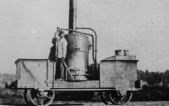Manawatu rail: Longburn Traditional Cache
-
Difficulty:
-

-
Terrain:
-

Size:  (small)
(small)
Please note Use of geocaching.com services is subject to the terms and conditions
in our disclaimer.
One of a series of simple, easy to find, caches at railway stations in and around the Manawatu.
Welcome aboard the Foxton-Palmerston tram service to Palmerston! Last stop Karere, next stop Awa Puni. Connection via the WMR service to Wellington leaves here, next stop Whitmore.
On the banks of the Long Burn, since renamed back to its original name, the Mangaone Stream, stands the small township of Longburn. In 1873 a wooden-railed, horse-drawn tram line was completed, running through here from the new township of Palmerston (23 houses at the start of 1872!) to the Government Wharf on the Manawatu River at Foxton. Wood was the principal export, the town of Palmerston stood in a natural clearing in a heavily wooded area. Settlers were the principal import. Indeed most of the line was constructed by immigrants, many of who were Scandinavians, as those who already had homes in the region were less willing to leave them to work such a long way away from home. The line was run as a private enterprise or 8 months before being handed over to Government ownership and operation.
The contract was for a steam railway, and in 1872 the line was long enough to make it worth bringing in the Sparrow locomotive to start work on the line and to assist with the further construction. The line from
| Palmerston had reached Nga Whakarau (just south of where the Opiki Road/ Himitangi turn off is today) and the Palmerston, New Zealand's first ever home built engine, built in the Sparrow workshops in Dunedin, was sent up river to meet it. The 10 horse-power wood burning Sparrow is reminiscent of a small open box car, just 5 meters long, with a centrally mounted vertical boiler. Maximum speed of 16km/h. Alas, the bedding and the rails could not support its weight, and horses took over the job before the line was finished. |

Palmerston, 1872
|
In 1874 work started to improve the foundation and replace the wooden rails with steel, which would allow the use of heavier loads; the main heavy load people wanted on the rail being, of course, the return of the Palmerston.
There was some bickering as to where a rail north from Wellington should run – east or west of the Tararua Range. A Royal Commission was set up in 1880 to resolve this, as well as greater plans for rail for the whole colony. They decided on the east coast, through Masterton, and recommended ceasing further work on the Johnsonville line. Which of course did not go over well here, and within 6 short years a band of businessmen had established and built the WMR – the Wellington-Manawatu Railway – from Wellington joining to the government-owned Foxton-Palmerston rail here, at Longburn.
Rail became the primary way to move people and cargo from Wellington to Palmerston (rather than ship to Foxton and rail from there) resulting in the slow decline of the Foxton rail. Just 3 years after the WMR started operating there was a article in Foxton's Herald lamenting the decline of passenger traffic via the port but holding out hope due to the booming flax and hemp industries. While passenger traffic declined, goods traffic increased.
However Foxton port continuously had problems with sandbars and shoaling in the river, and eventually these gained the upper hand. More and more ships refused to dock there. The lack of a reliable port was offset by good quality roads with private cars and trucks providing feasible alternatives for goods carriage. Eventually, in 1951, a Royal Commission recommended ithe line's closure but it was not till 1959 that the final train ran (rather a celebratory affair).

Longburn station and yards, 1889.
Foxton rail is between the road and the buildings, from the left edge to the back of the station,
WMR rail is in the foreground, Palmerston township lies to the right.
Now all the rails from the original Palmerston - Foxton route are gone, but in many places you can still see where the rail ran. The Palmerston-Foxton rail ran down the little road here, you can see where it extends beside the bridge. The WMR rail curved and came up the main road to the station and platform which was where the grass is now, the station being directly opposite the dairy here. Now, of course, the WMR rail heads away from the main road, starting on the Milson deviation to Palmerston North station, on the (almost) edge of town.
The cache is a small plastic jar. FTF gets to FTF a new TB. Good luck!
References:
Cassells, K.R.: "The Foxton and Wanganui Railway", published by the New Zealand Railway and Locomotive Society, 1984.
Additional Hints
(Decrypt)
Ernpu hc naq va